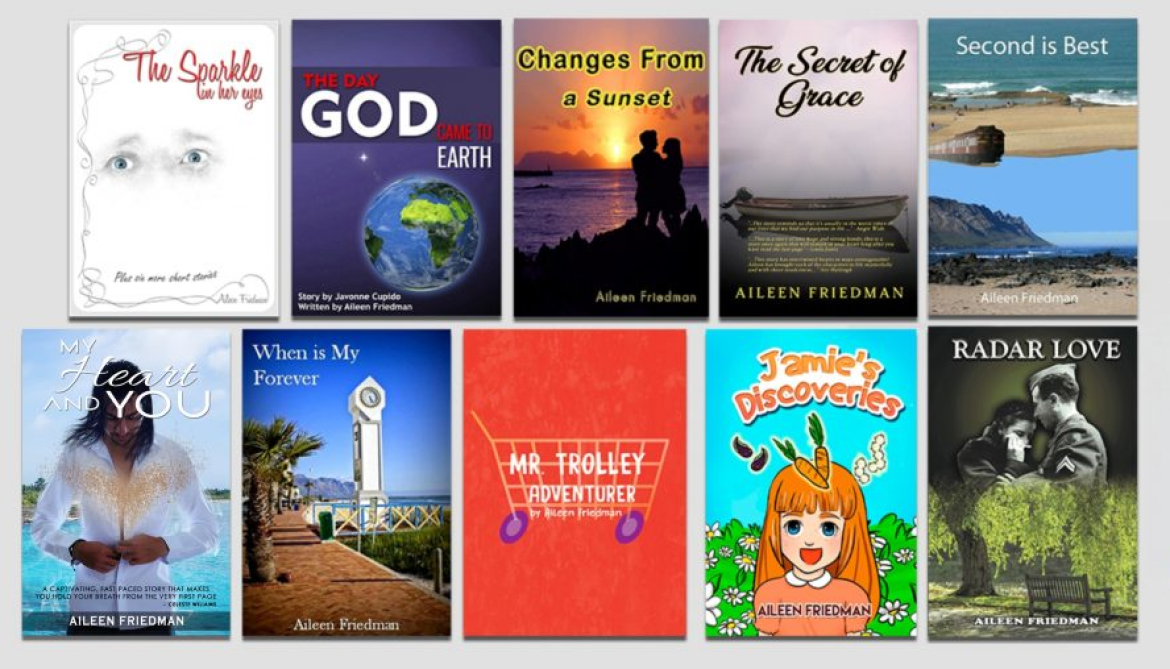Things to remember when in Cambodia
Cara (my daughter) when making the reservations at the Siem Reap Pub Hostel, in Siem Reap, Cambodia, she also arranged for a shuttle bus to collect us from the airport. A shuttle? We were greeted by a friendly man with a lovely smile, and he introduced himself as Ron. We only had backpacks, and so he led the way to the shuttle. We both stopped mid-step and squealed with excitement – our shuttle was a tuk-tuk; absolutely fabulous.

Arriving at the hostel, we were quickly found out about the tours we had arranged for the next three days and were delighted to find out that we were to be chauffeured around by none other Ron. From then on Ron was aptly called Captain Ron.


The adventures waited upon us.
As far as hostels go the Siem Reap Pub Hostel is one of the best I have stayed in. Your first contact with the staff is welcoming, friendly and they speak English relatively well. Most things are explained in detail – there were one to two matters that were not clear which I will explain later. Our room was functional; it was clean and had everything we needed – shower, flushing toilet, hot water, hanging cupboard, TV (we never used it), air-con and a comfortable double bed.
We paid $52 for four nights – not including meals. Really good value for your money!


Before going anywhere, Captain Ron took us to the provincial ticket office. We paid $62 each for a three-day temple visit. Your photo is taken and printed on the ticket. With this ticket, you may enter any temple for that day and the two days following. An official will request your ticket before entering any temple, so it is imperative that you have this on you during the temple tours.


We would do the following tours on our three days there;
Day 1. Big temple tour – 26km.
Although Angkor Wat was not on the temple to visit for the day, we asked to go there to watch the sunset. Unfortunately, the sky was so cloudy there was no sunset. But on the plus side; because it was so late and cloudy there were very few people there, and we were so lucky to get incredible photos of the temple without any people in the shot. It was as though the temple was ours for the day.
Day 2. Small temple tour – 17km.
- Angkor Wat (sunrise 5 am)
- Angkor Thom Complex
- Bapuon
- Bayon
- Elephant terrace & leper king terrace
- Thommanon
- Ta Keo
- Ta Phom
- Banteay Kdei
Day 3.
The Temples
Instead of laying out a detailed explanation of every temple and activity, I will only do my favorites.

This is an experience; it is majestic and proud. It was built in the 12th century between 1113 and 1150. It is the biggest of the temples in Cambodia. As I said before being there with so few tourists was a thrill, and we were able to absorb so much more of its history. There is so much information available on Angkor Wat that I would rather tell you about a little incident that is useful information. After viewing the sunrise, we immediately went up to the very top of the temple where you can get a magnificent view from the highest tower. After waiting for about forty minutes and being told where to stand to enter (only a few people are allowed up at a time), they opened the entry. I was about fifth in the line and the same woman that told me where to stand told Cara and me that we were not permitted to enter as we had sarongs on over our shorts. We objected because we were told that as long as our legs and shoulders were covered, it is fine to enter the temples. This lady said that we had to either have pants on or a wrap around skirt (please tell me the difference). We objected a bit more, but all we were told was to go down to the bottom and buy a skirt or pants. This bodes as nothing but a money making scheme for the peddlers. We left rather frustrated but still satisfied that we got to visit this, the oldest and biggest temple with practically no one there the day before.
View more photos of Angkor Wat here
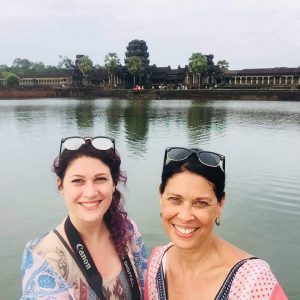



The Bayon was built in late 12th century and late 13th century. This is an extremely complex and compounded temple almost like a maze due to the architectural changes as and when the different religions ruled (from Greek, Hindu and then Buddhist).
Unlike the other temples, there is no surrounding wall so entry to the temple can be from various points. Once you’re inside it can almost feel claustrophobic with its narrow corridors, stairways, and chambers; but, once you’re on the top level the view is awesome, and you can feel the peace the towers and the faces on them offer. The towers dominate the temple; there are 37 remaining out of 57.
The downside to visiting this temple is that when it is crowded with tourists, it becomes very difficult to maneuver between the narrow corridors, chambers, and stairways.
View more photos of the Bayon here


Built in the late 12th century, 1191 and is one of the largest in Cambodia. During its prime, Preah Kahn hosted over 1000 teaches and was a Buddhist university.
This temple has two entrances at both West and East sides. You can walk through from the one to the other. Usually, your guide will drop you at one end and collect you on the other side. It is a very spacious temple, and I am sure in its day it was lavish and grandiose. Entering on the East side, you will cross over a naga bridge. (Naga means Churning of the sea of milk) The bridge is protected on either side by devas (female divinities) and at the head a Vasuki (King serpent).
There are many chambers linked by passageways. There are beautiful trees (but not like Ta Prohm), and one can sense the history in the walls. The stupa (a stupa is a dome-shaped structure erected as a Buddhist shrine) was added to the temple in the 16th century; it is situated in the center of the temple. In the walls surrounding the stupa are holes; brass plates were inserted into these holes. Imagine the reflection when the light entered this area of the temple!
Every day from 1 pm to about 3 pm we were showered with thunder and rain storms. We were caught in a huge storm while visiting Preah Kahn. Cara and I thoroughly enjoyed the experience, and I wish I were able to capture the colors of the temple walls and foliage after the rain – simply exquisite.
View more photos Preah Kahn here

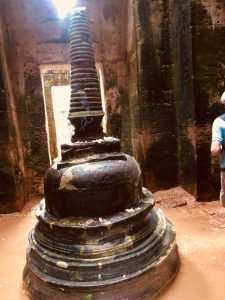


This is the temple where Tomb Raider was filmed. This temple takes your breath away with the majestic trees the have enfolded the structures; it is my favorite of all the temples.
As with most of the others, it was built in late 12th century and the 13th century. It is a great state of ruin due to the trees that have rooted around and lifted the structures. It was originally named Rjavihara which means Royal monastery.
Ta Prohm is romantic to the core with the majestic trees and the color contrasts between their roots, the grey/brown stone, and the greenery. One can almost feel that you are lost in a mystical fairy palace.
Two tree species are of significance.
- The larger of the two is the Silk Cotton tree (Ceiba pentandra). Its greatest feature is the thick, pale brown roots (almost gold plated in color) with a knobby texture. To stand next to this tree you cannot but be in awe of its brilliance.
- The smaller is the Strangler Fig tree (Ficus Gibbosa). It is much thinner with smooth grey roots.
The temple has not been restored in most sections because if they were to remove the trees (which would be such a great sadness), the temple would completely fall apart. The roots of the trees – the larger in particular – have rooted themselves around the structures of the temple and therefore as they have grown, they have opened the connection of the bricks/blocks. The foundation is in a similar state and so these trees of some 400 years are what is holding the temple together. To see them wrapped around the temple makes me believe they were meant to be exactly as they are – joined together for all the existence of time.

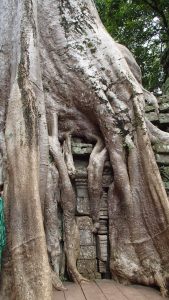
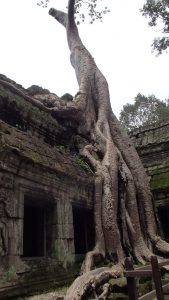
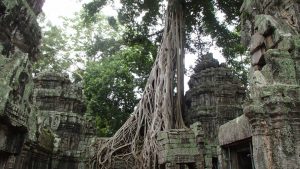
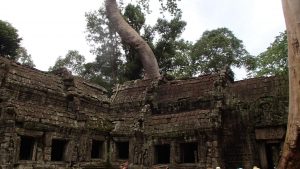
View more photos of Ta Prohm here
In every temple are inscriptions on the door-jams of the entrances as well as steles. A stele is an upright slab bearing inscriptions of the temple and its history. The majority of these steles are preserved in a conservatory at Angkor. Many of them were stolen for monitory gain.

View photos of the other temples here
I cannot find the words to fully describe the colors that radiate off the temples; from brown, orange, grey and greens, and all depending on the light angles the richness in the colors change. It is mesmerizing.
There are monkeys around very temple, they are so acquainted with humans and will hang around you for food. If you happen to sit nearby and have any tassels or the like on your clothing they will make themselves comfortable by you and chew on the tassels. They also like handbag strings and such, gentle remove yourself from them and all will be fine.


At every temple site are people selling a book “Ancient Angkor” by Michael Freeman and Claude Jacques, (ISBN 974 8225 27 5), for $15. This book is a great source of information on every temple and is really worth the purchase.
I feel blessed and honored to have walked through these temples and stepped back in time.
Floating Village
When we left the hostel for the floating village, we paid our guide $18 as this is what we understood the fare to be. It is approximately an hour drive in the tuk-tuk so leaving at 8 am is reasonable. The trip there is a bumpy one; I almost flew out of the tuk-tuk a few times when we hit potholes in the road. For most of the journey it is along a tarred road, but for one-third of the journey just outside of the village it is all dirt surfaces. They are constructing a road directly to the floating village, so the dirt road is a detour road which makes the surface even worse.
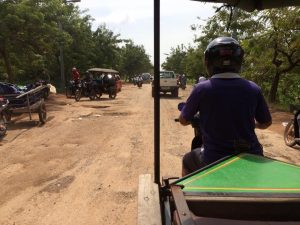
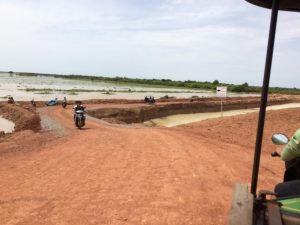
A kilometer or so before the village we stopped and Ron took us to a ticket office. Since this was not communicated to us at the hostel, we did not know that we had to pay $25 each for the tour through the village. They do not accept credit cards, and there are no ATM’s; so if you do not have the cash on you, you have just wasted an hour trip for nothing but to look at the scenery. Fortunately for us, Captain Ron had money on him and paid for us (we paid him back as soon as we got back to the hostel).
Our guide on the boat was very pleasant and friendly, a few meters into the trip we picked up his wife and baby, and they got off at a restaurant where she worked. Naturally, the child loved Cara as all children do. We were allowed to sit at the very front of the boat to capture everything; I have never been more grateful for a selfie stick as I was on this trip. It is truly fascinating to see how people live on the water.
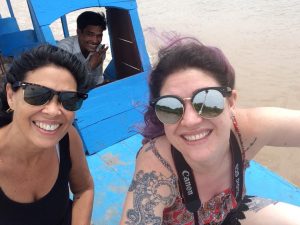

The houses are built on 20-meter stilts and very close to each other. Our guide told us that the families stay together and in some houses, there are up to five generations / 15 people living in one house. Fishing is the major source of income, and almost every man is a fisherman. It is truly all they know – to be a fisherman.

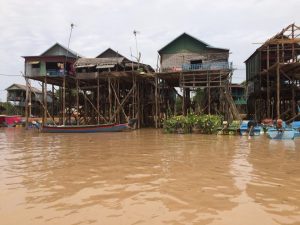
The trip through the channel is 2 hours (if you take a small boat trip too) and halfway to the mouth of the channel that meets the lake you stop at a floating restaurant. You can also take a small boat trip through the mangroves and meet up with your guide and boat at the lake entrance for a fare of $5 each (another minor detail not relayed to us at the hostel). We opted to stay on our boat and continue on to the lake.
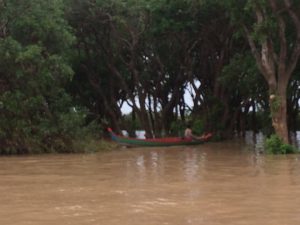
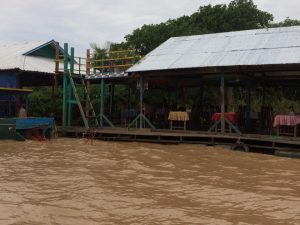
Your first impression of the lake is “WOW” it looks like you are in the middle of the ocean. It is vast, as deep as it is wide. The lake covers 5 provinces and 124 floating villages. At the edges of the lake, it is 3 meters and 10 meters in the center during the rainy season, which is when we were there. In the dry season, there is only 1 kilometer of water the entire lake. During the rainy season, the channel is 6 meters and only 1 meter in the dry season. So as you can see the difference in water levels is huge depending on the season, and therefore their source of income is very seasonal. The water is dirty brown in the rainy season, but in the dry season, it is so clear you can see the bottom of the lake.
When we flew out of Cambodia we flew over the lake – indeed it is massive.
View more photos the Floating Village here


The Killing Fields
We were rather disappointed with “The Killing Fields.” Not to be sadistic (I am absolutely not, and neither is Cara) but we were under the impression of visiting a place resembling the name. To view the actual sites, we would have to visit the outskirts of Phnom Penh a few hours from Siem Reap. What we did visit is the Wat Thmey temple that is erected on one of the areas that served as a killing field. There are numerous killing fields throughout Cambodia. A large stupa memorial filled with the skulls and bones of victims is in the center of the memorial site, about 8000 bodies were found here. There are several signboards with the history and images of the genocide. I could not help but feel the horror and let my tears flow.
There is no entrance fee to the memorial site.
View more photos of the Killing Fields here

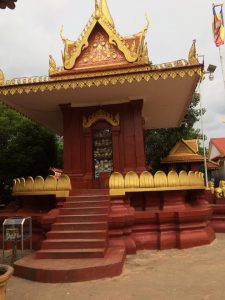

War / Landmine Museum
On our way to the War Museum, we encountered the usual rainstorm; only this one was intense and lasted for longer than usual. Our poor Captain Ron even with his raincoat on was soaked; he dropped the covers on all the sides of the tuk-tuk so we were protected.
The entrance fee is $5 and is outdoors, and this meant we had to wait out the rain in a small gift shop. Eventually, a tourist handed back the museum’s one and only umbrella and we headed out in the rain to view the military wrecks from times I am glad I did not live in.


The museum was more about landmines and had so much information on these horrors in a big exhibition hall. Reading the history of these landmines and the tragedies that occurred here I cannot believe that human beings can be so vile and heartless. There are still many landmines in Cambodia today; fortunately, there are people with heart that are working endlessly to rid this beautiful country of this monster.
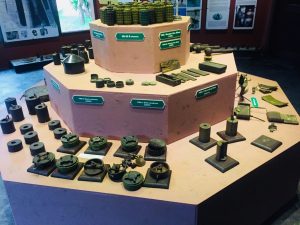

The people of Cambodia have come a long way from those atrocities and have faced the worst of wars but, they are the friendliest people with the most beautiful smiles. They have captured my heart.
View more photos of the War / Landmine Museum here
Siem Reap, Cambodia
The most popular tourist destination in Cambodia is Siem Reap, and this is because of the temples. This city is fantastic, besides the temples, there is so much to see and do; I was enthralled by the vibe and energy here.
A 30-day tourist Visa for Cambodia is obtainable only on arrival. It costs $30, and you must take a 4 x 6 passport photo with you. On arrival in the airport go to the immigration counter, fill in a very uncomplicated form and hand it in with your photo and your payment. Move down to the next counter and wait for your name to be called out and collect your visa. The whole process takes approximately half an hour, it is effortless, and the officials are friendly. Don’t panic that you will not know where to go, you are guided, and also you have nowhere else to go but to the immigration counter.
Siem Reap is a very interesting and intriguing city. The main roads are tarred with what I presume is a thin layer of asphalt, the rest of the roads are dirt surfaces with large potholes. Along the main road of Siem Reap are massive five-star hotels and resorts – plenty of them.
If you’re concerned about WiFi you needn’t be; there is free WiFi in every hotel, hostel, restaurant or public service. The connection is excellent, and in most places, there will be signs posted on the walls with the WiFi and password, or you simply ask, and they give it to you. Also, almost everyone speaks English fairly well; we rarely got lost in translation.
As I previously mentioned it rained every day (in the rainy season) and therefore the roads were a mess but, the people were not deterred; as soon as the rain is over they sweep off the water from the front of their shops or market stalls and continue on. Along the roads don’t be surprised to find cattle. Seeing the cow for the first time, it is easy to get the impression that they are underfed, but these cows are the Zebu breed. They are skinny, have a hump on their backs, droopy ears and a large flap of skin under their necks.. typical of a cartoon cow. Unfazed by the traffic and people these cows are bred for livestock as a good source of income. From what Captain Ron told us they export them to Vietnam for good money.



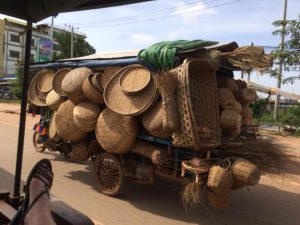
If you’ve seen any movies or photos of Cambodia, you will have probably seen rice paddies. There are fields and fields of luscious green rice paddies, some drowning in water and others blowing in the wind. Out in the countryside, the villages use the side of the road to dry out the rice; motorist respect this and steer clear of the rice which only adds to the madness on the roads.
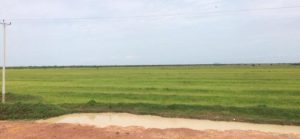
No matter in which direction you’re going there are temples and shrines alongside the road; big, small, old, new, derelict or immaculate there are so many.
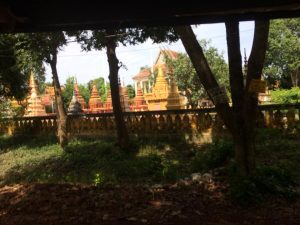
Let’s talk about the Cambodian food; one or two words to describe it – absolutely delicious. In most of their food, they use an oyster sauce or something similar, whatever it is your taste buds relish every bite. Rice is served with every meal, and even without the rice, your meal is sufficient and satisfying. We never ate at the same restaurant more than once and were never disappointed. Restaurants are not in fancy buildings or with fine dining; I am sure there are such restaurants, but I would never know where they are. Restaurants are in the hive of the markets or on the street sidewalks with the basic necessities. It is not about the décor; it is about the food. Fresh juices are very popular and are as they say fresh; mango is a favorite in Cambodia, and I enjoyed every glass I had. There was one thing that I had for the first time and was totally enthralled by it – rolled ice cream. The ice cream (in liquid form) is poured onto a flat surface and then constantly chopped up and mixed again until it is has thickened. It is flattened into a rectangle shape and then cut into slices, and the slices are then rolled. The rolls are put into a cup and sprinkled with whatever topping you selected. So very yummy!


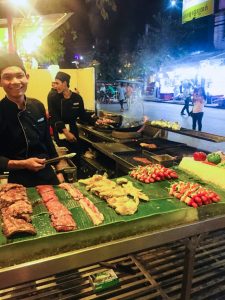

On our third day between visiting the killing fields and the war museum, we asked Captain Ron to take us to an authentic Cambodian restaurant, where the locals would eat. The only thing I was able to eat was a very dry fish cake; the rest was too spicy. Cara and I did share a coconut (we drank the coconut juice out of the coconut).
Somewhere while tasting all the different foods and thoroughly enjoying them I pick up a mild case of diarrhea, so be careful when devouring their cuisine.


I promise you one thing; you will not leave Cambodia empty-handed; the markets sell everything you can think of. Right around the corner from our hostel is the night market. It is huge, and while most shops or stalls are open in the day at night, this place comes alive. Yes, a lot of the same stuff is sold in most stalls but if you dig around you can come with some gems. Everyone you pass will tell to look at what they have to sell; you get used to this just smile and walk on. Prices are really value for money, and in Cambodia, the dollar is gladly accepted, very few places take credit cards so always carry cash on you (the ATM’s are very safe). Between the shops are many massage spas, and nail therapists; the market in Siem Reap has a fabulous vibe all of its own.
View more photos of Siem Reap here
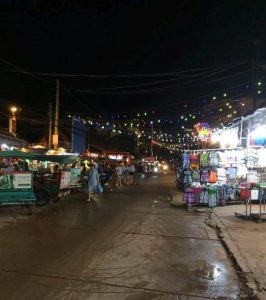

Things to remember when in Cambodia
- Always take off your shoes when entering the premises (this is not required at the restaurants but is at your accommodations and most other establishments).
- Thunder and rain storms between 1 pm and 3 pm almost every day during the rainy season – May to November.
- When entering the temples, you MUST cover your shoulders and legs (sarongs are not acceptable in the high tower at Angkor Wat).
- WiFi is Free everywhere even in the small little places.
- Almost everyone speaks English fairly well.
- An average meal for 2 people will cost about $8 – $15, purified water is given free with your meal.
- Use a tuk-tuk for transport – the best way to travel.
- Cash is king – very few places take credit cards, ATM’s are safe anywhere.
- When exiting Cambodia, make sure you have already booked a check-in bag. If you ask for it when checking in, they will charge you $80 per luggage item – very expensive.
- Cambodian food is wonderful, but you can easily get diarrhea. Fortunately, the pharmacies sell Imodium.
Don’t hesitate on an opportunity to visit Siem Reap, Cambodia; you will not be sorry. It is an experience of a lifetime especially if you love to visit historical places and Cambodia has some of the best in the world.
